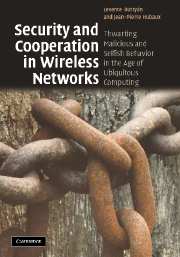 Security and Cooperation in Wireless Networks
Security and Cooperation in Wireless Networks from Part I - Introduction
Published online by Cambridge University Press: 05 June 2012
Introduction
As we have seen in the previous chapter, the development of wireless networks has followed a centralized pattern: the network infrastructure (meaning all pieces of equipment except the terminal) has remained under the full supervision of the network operator, who traditionally used to be a large organization, very careful at respecting the legislation (and at nurturing the value of its own brand). As a result, the users generally tend to trust the operator, but do not generally trust the other users.
As we have also seen, current technology such as WiFi makes infrastructure equipment (and in particular access points) affordable to very small operators or even individuals, thus allowing the emergence of community networks and similar initiatives.
In this chapter, we will show that we are only at the beginning of this evolution, and that not only WiFi, but also other wireless technologies are about to dramatically transform the deployment and operation philosophy of wireless networks. As a consequence, the notions of authority and of trust need to be completely revisited, and this is exactly one of the reasons for writing this book: the novel organization of the wireless networks calls for a thorough study of the possible malicious and selfish behaviors, and of the techniques to thwart them.
In order to be as concrete as possible, we will first provide a certain number of examples of emerging wireless networks, spanning personal networks, vehicular networks, sensors, and RFID (Radio Frequency IDentification, described later in this chapter).
To save this book to your Kindle, first ensure [email protected] is added to your Approved Personal Document E-mail List under your Personal Document Settings on the Manage Your Content and Devices page of your Amazon account. Then enter the ‘name’ part of your Kindle email address below. Find out more about saving to your Kindle.
Note you can select to save to either the @free.kindle.com or @kindle.com variations. ‘@free.kindle.com’ emails are free but can only be saved to your device when it is connected to wi-fi. ‘@kindle.com’ emails can be delivered even when you are not connected to wi-fi, but note that service fees apply.
Find out more about the Kindle Personal Document Service.
To save content items to your account, please confirm that you agree to abide by our usage policies. If this is the first time you use this feature, you will be asked to authorise Cambridge Core to connect with your account. Find out more about saving content to Dropbox.
To save content items to your account, please confirm that you agree to abide by our usage policies. If this is the first time you use this feature, you will be asked to authorise Cambridge Core to connect with your account. Find out more about saving content to Google Drive.